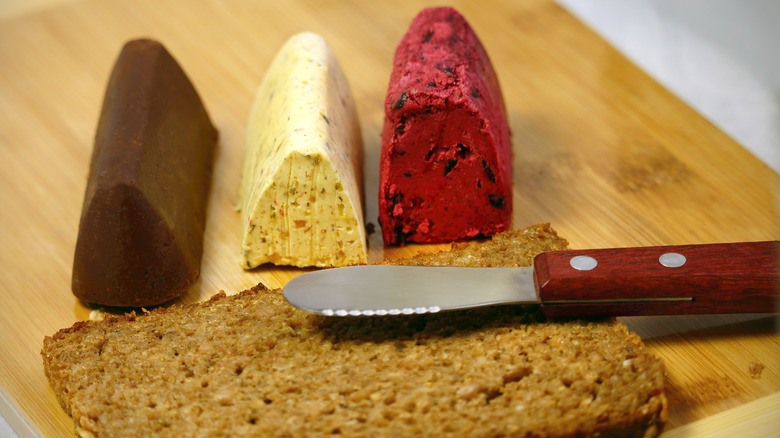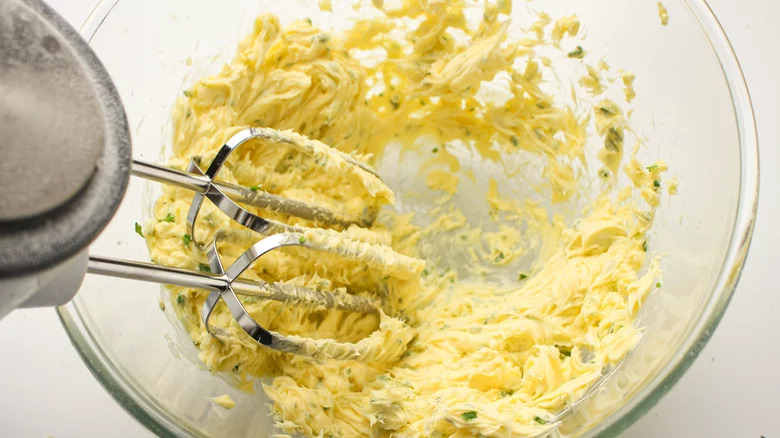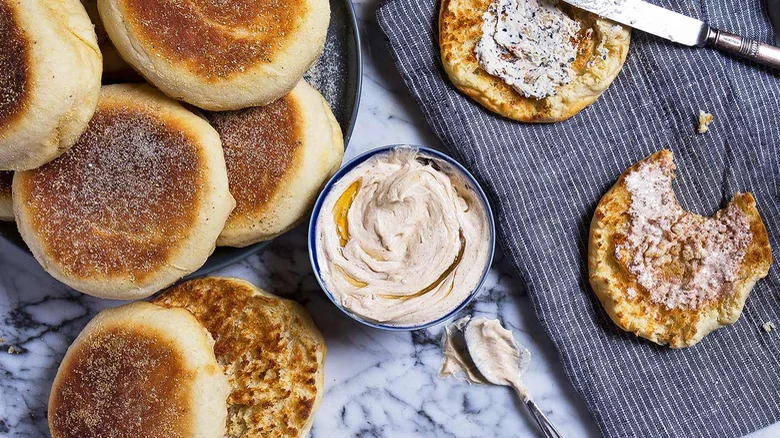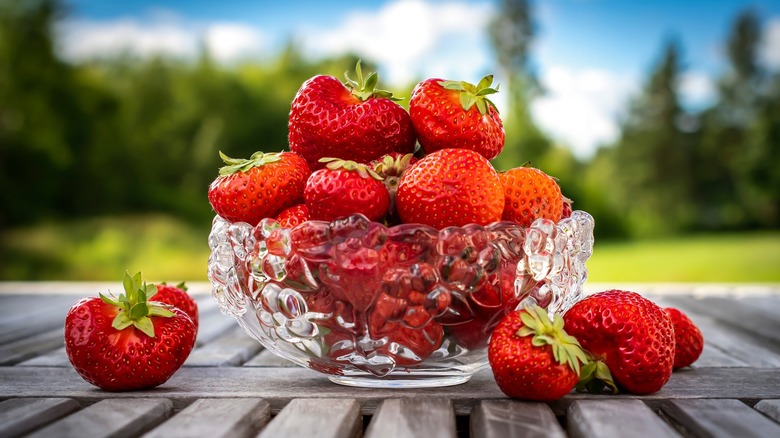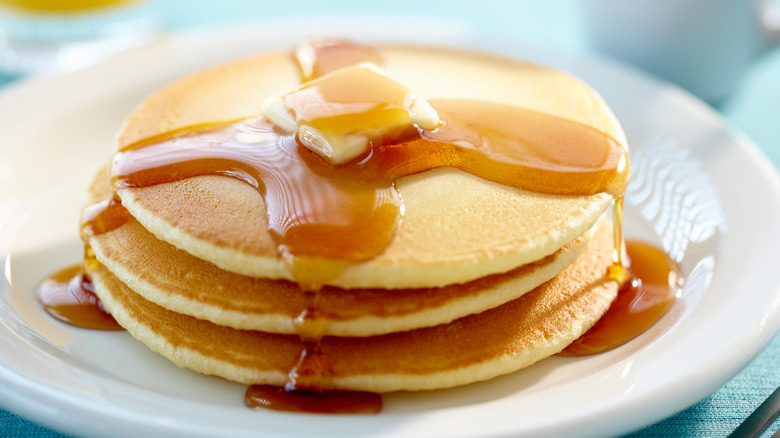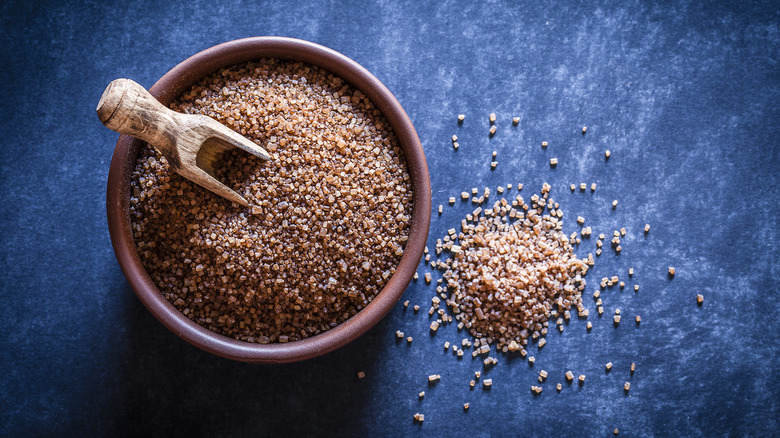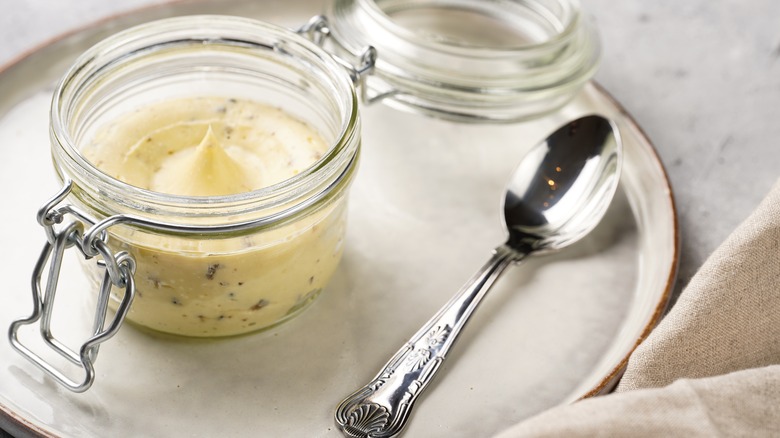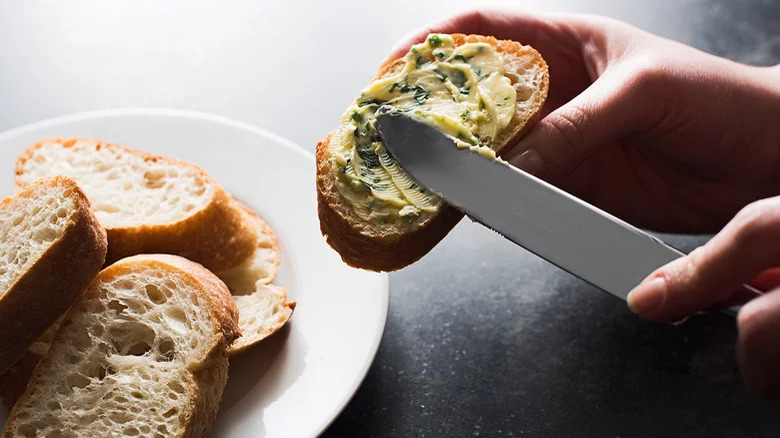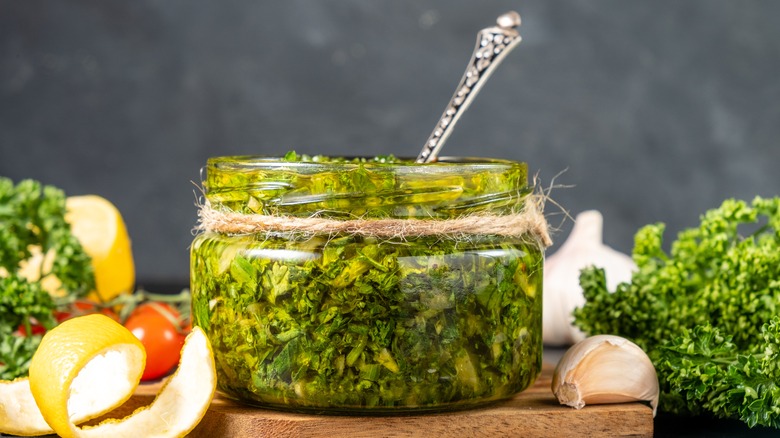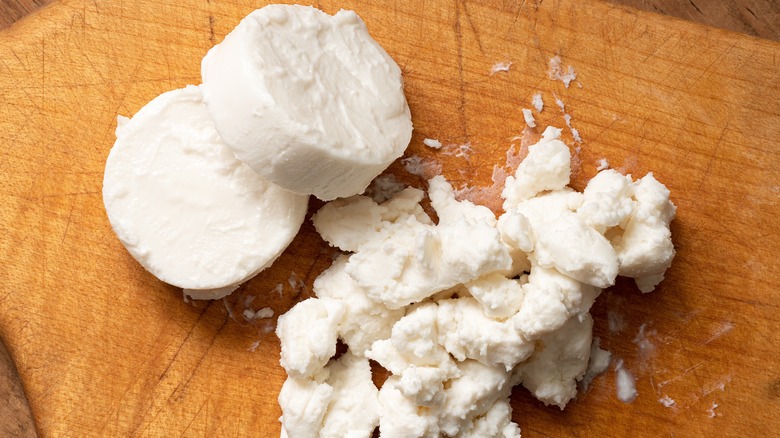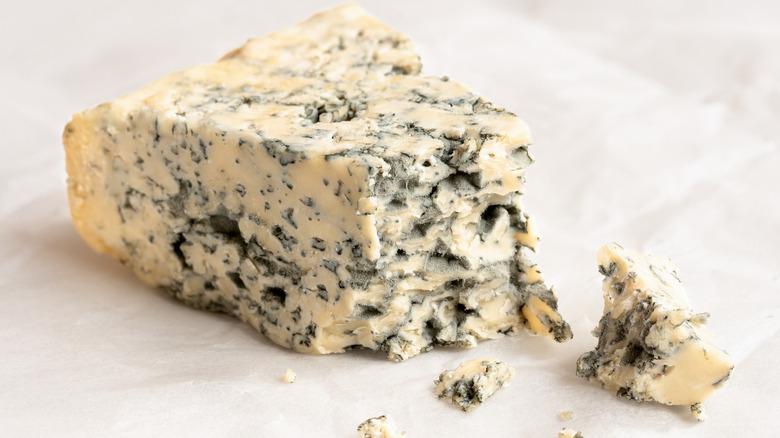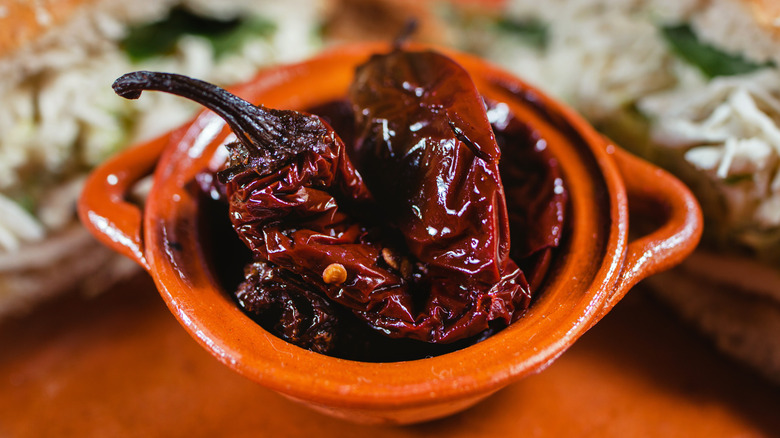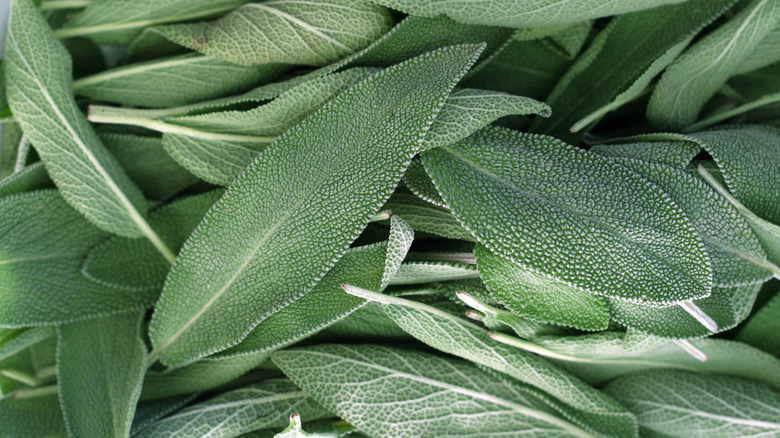15 Best Ways To Add Flavor To Butter
Butter is generally a welcome addition to nearly any dish. However, you don't have to stick to using classic old butter all the time. Add a unique twist to a meat or fish recipe, or even just a new spread for bread, by creating a compound butter. Infuse all sorts of flavors in every day butter to elevate and complement the particular taste of your next meal, adding the upscale touch of a steakhouse or gourmet seafood dining experience to home cooking.
Discover not only the best flavors to use — some simple and some highly surprising and unexpected — but also the greatest potential pairings for each flavored butter. Use the tips and tricks below to make fancy compound butters in almost no time at all; indeed, most of the recipes take only five to ten minutes to complete. These new creations are sure to impress guests at your next dinner party, or simply add more complex, nuanced flavors to a meal.
Mix in garlic for a flavorful boost to bread and butter
One of the simplest ways to add flavor to butter is to gather three simple ingredients: salted butter, minced garlic cloves, and fresh parsley. Whisk them together and the result is a highly versatile flavor that can be used in a variety of dishes. Garlic herb butter goes well on bread, pasta, steaks, seafood, and can even be incorporated into a simple but delicious mashed potato recipe.
As long as the new condiment is preserved in an air tight container, it will last in the fridge up until the expiration date of the original stick of butter used. One of the interesting things about this method of adding flavor to butter is that salted butter is preferred; most recipes for flavored butters call for unsalted, which is more of a bland base that can absorb the flavors of the new ingredients, and allows for better salting of compound butter to taste.
Add spiced honey for a sweet flavor
If desiring a perfect brunch butter for pancakes, waffles, biscuits, or other assorted breakfast foods, try making a spiced honey butter. Since the texture of this particular butter should be light and fluffy, the key is to whip the butter for at least five minutes before adding any additional ingredients. Make sure to take the butter and honey out of the refrigerator before starting the flavoring process, as both ingredients should ideally be at room temperature. If they are still frozen, it will be hard to create the whipped texture that makes this spiced honey butter so delicious (and spreadable).
Once the butter is whipped into shape, add a dash of spices, including nutmeg, cinnamon, flake salt, allspice, and cloves. Continue to whip the ingredients and butter together for a few minutes. After everything is thoroughly combined, carefully fold the honey into the butter mixture.
Blend in strawberries for a fruity spring accent
Strawberries are one of the most delicious fruits around, but they also typically come in big packages, almost guaranteeing some will be left in the fridge until they spoil. Instead of letting those sweet, fresh strawberries go to waste, why not use a few of them to add a fruity taste (and pink hue) to a stick of butter?
Mash or small dice the strawberries, then use a mixer to incorporate them into the butter. If the mixture ends up being too chunky, add a little water or milk to create a smoother consistency. For an extra fancy touch, mold the butter into a log-like shape and put it in plastic wrap. This makes it easier to store in the fridge, as well as slice that newly formed strawberry butter. Put it on bagels, muffins, or biscuits, and enjoy a bright spring breakfast.
Whip butter and maple syrup together for a special pancake topping
If maple syrup is too messy or sweet for morning pancakes, add it instead to a stick of butter, in effect combining the two most often used pancake condiments. Interestingly enough, combining the two slightly alters their flavor. Whipping the maple syrup into it smooths out the butter's consistency, while the butter negates some of the maple syrup's sweetness, which can be overpowering for some people.
For the best possible result, cut the butter into small cubes beforehand, then add a dash of salt to the mixture before combining the ingredients together. If planning to use this flavored butter often, store it in the fridge, where it will last as long as the original stick of butter. If the plan is to only use the maple butter once in a while, perhaps for a decadent Sunday brunch, store it in the freezer, where it can last up to six months without losing much of its flavor.
Add brown sugar for a brunch delight
Add a quarter of a cup of dark brown sugar and a dash of cinnamon in order to create a rich, almost toffee-flavored butter that pairs well with relatively bland foods like carrots, oatmeal, and toast. Mix in the brown sugar for a while, probably ten to fifteen minutes, in order to avoid the grainy texture it can create in the butter. For an extra indulgent brunch, pair the brown sugar and cinnamon flavored butter with French toast. The dark brown sugar adds a slightly bitter note, which goes well with the egg and milk fat in the French toast recipe.
Alternatively, use light brown sugar instead of dark. This will add a caramel-like note to the butter and give it an overall sweeter taste. Either way, the brown sugar butter can help add flavor to a whole lot of healthy — if not very tasty — foods, so you can better enjoy eating them.
Mince truffles for a deliciously aromatic butter
To infuse butter with a savory, earthy flavor, try adding some truffles. Since they can easily overpower any dish, it's best to mince the truffles and add relatively few, small, fine pieces into the butter. Truffle-flavored butter goes best with hearty dishes like steaks or baked potatoes.
Also worth noting: That stick of butter can absorb the truffle aroma without even physically being combined with truffles. Freshly harvested truffles can be stored in the fridge (preferably on the same shelf as the butter), and the aroma is so strong that it will waft into a lot of nearby ingredients, giving them a touch of truffle flavor.
Butter is particularly prone to taking on the aromatic properties of nearby truffles, as they are fat-soluble, and therefore accumulate more easily in fatty substances. Don't worry about taking the butter out of its wax paper wrapping; truffle aromatics are so strong that they will pierce through the wrapping, much like they pierce through eggshells. If the butter is in a box, however, remove it so it's resting only in its wrapping.
Infuse red wine to elevate your next ribeye
It's common knowledge that steaks are best paired with red wine. Less frequently considered, however, is the concept of a red wine-infused butter that could be every bit as complementary to that hunk of beef.
The process for adding a red wine flavor to butter is a little more complicated than just mixing the two together, however, so it is crucial that the recipe is closely followed.
Pour red wine into a pan, and boil finely chopped shallots in the wine. After the wine is almost fully cooked out, let the shallots cool. They will have taken on the wine's flavor. When the shallots are at about room temperature, mash them together with butter, parsley, and a little cracked black pepper in the food processor. There will still be pieces of the shallots and parsley in the red wine butter, which will attain a pretty pink tinge. Since the butter will be hard, store it by molding it into a log and wrapping in Saran Wrap or any cling film, as fitting it comfortably in a jar may be difficult.
Add herbs to create a bright pasta butter
Some fresh spring herbs can help add a crisp, light flavor to the rich, fatty sticks of butter sitting in any refrigerator. Though various cooks like to create compound herb butters with their own particular mixes, one of the best (and simplest) recipes calls for nothing more than everyday ingredients already lying around most kitchens, making this particular herb butter a great one to make in a pinch.
Finely chop some parsley and chives, zest a lemon, and add it all into a bowl with room temperature butter and some kosher salt. Blend them until everything has been incorporated. This will create a subtly flavored herb-infused butter that can be used on a variety of meals, especially simpler pasta dishes. Otherwise, serve it alongside a basket of freshly baked bread before dinner in order to create an upscale restaurant atmosphere right at home.
Create a Mediterranean flavor with sun-dried tomatoes
Sun-dried tomatoes have become popular additions to pastas, sandwiches, salads, soups, and a never-ending variety of dishes calling out for a touch of warm, slightly acidic Mediterranean flavor. So, it may come as no surprise that they also work well in adding a unique flavor to butter. A little squeeze of lemon juice in the butter will help bring out the tomato flavor; add a touch of other ingredients, preferably those which align well with Mediterranean cuisine (like thyme or garlic) to further enhance the flavor.
The only downside to sun-dried tomato butter is that it lasts about a week or two in the refrigerator, at most. Smaller chunks can, however, be stored in the freezer for longer periods. The good thing about this compound butter is that it can make a great snack just spread over bread, so it seems unlikely to sit around uneaten for too long.
Recreate chimichurri sauce in butter form
Chimichurri sauce hails from Argentina, where it is made with a combination of parsley, garlic, oregano, and chilies. This mixture of herbs and spices is combined with vinegar, salt, and olive oil to make one of the greatest steak sauces in the world. After becoming popular in South America, with slightly different flavor variations in different regions, it has now become a staple in steakhouses all over the globe.
Thanks to its blend of ingredients, chimichurri imparts an herb-filled, sometimes slightly spicy flavor onto any food it accompanies. Add chimichurri to butter to bring a unique brightness to its usually rich, creamy, and heavy taste and texture. To make it, simply go about making chimichurri, but substitute butter for olive oil; be careful how you add vinegar to the mixture. Since vinegar and butter generally don't mix well, add vinegar one small splash at a time, and make sure to combine it thoroughly with the butter before adding any more.
Mix in goat cheese for a decadent dairy spread
An increasingly popular element of fine dining in recent years is the ordering of the ubiquitous charcuterie board, sharing cheeses, olives and spreads with friends. It can be fun to try creating these boards at home by putting a twist on some of the more classic offerings. For example, add some goat cheese to butter to merge the tangy, cheesy taste of the former with the rich flavor of the latter, resulting in a delicious new flavor.
The great thing about adding goat cheese to butter is that it gives a lot of flexibility for what spices or herbs can be added on top of the two basic ingredients. Choose a fresh flavor like basil, a classic goat cheese accompaniment like honey, or paprika for a sweet and peppery taste. Just mix it all together and serve on a board, or spread on bread for a delicious snack.
Add a dash of blue cheese for a flavorful steak topping
Add blue cheese to butter to create an extra rich, decadent condiment. This particular compound butter works best for those who like to indulge in strong flavors, as blue cheese butter pairs well with a juicy steak. What gives the cheese such a strong flavor in the first place? It's made with a fungi called Penicillium roqueforti, which breaks down the fatty parts of the cheese, changing those sections into different compounds and giving blue cheese its identifying blueish-green marks.
Because blue cheese is so pungent on its own, add only a relatively small amount; the taste can quickly become overwhelming. Combine the blue cheese with softened butter, season with salt and pepper to taste, and then refrigerate the mixture for at least half an hour. Blue cheese butter is among the rare combinations that is best served cold; instead of waiting for the mix to thaw and reach room temperature, place a cold round disk of blue cheese butter on a steak of choice, then let it slowly melt over the meat.
Blend chipotle and garlic for a smoky finish
Some butters can be employed during the cooking process itself, rubbed over ingredients to imbue unique flavor into the finished product. Adding roasted garlic and chipotle to butter creates a compound butter that works equally well for both the purpose of serving and of cooking.
For the best result, bake garlic cloves in olive oil before using them; it takes a little extra time, but the end result is worth it. Put the cloves, chipotle chiles, unsalted butter, and salt into a food processor and mash them together until they are thoroughly combined. This results in a slightly spicy, smoky roasted garlic compound butter that can be stored for two weeks in the fridge, or three months in the freezer. Make sure to chill the butter before using it, as it tastes the best somewhat cold — not to mention that in this form, it can be rubbed over meats like turkey or steak while cooking them, giving them a smoky, chipotle flavor.
Sprinkle in basil for a subtle, delicate taste
If looking to put a little extra oomph in the butter that will get slathered all over corn on the cob, some fresh basil will do the trick. The sweet and savory flavor of this widely used herb, combined with its slightly minty undertones, perfectly complements the summer treat of grilled corn.
To make the basil butter itself, mince basil and garlic, combine them, and then add salt and black pepper to taste. A food processor will make this part easier, but if you are confident you can mince the ingredients finely enough, doing it by hand helps preserve a little more of the flavor. After all the ingredients are combined, add slices of butter and mix everything together. The subtle, yet slightly contrasting flavors of the basil add a level of complexity to the straightforward creamy delicious taste of butter, and the combination can elevate a variety of dishes.
Mix in sage and melt for a woodsy, buttery sauce
There are a handful of butters best appreciated in the condiment's melted state. If you want a unique melted butter packed with flavor, try adding sage leaves to the mix. Thanks to the complex flavor of sage, a mix of earthy tastes with notes of pine, mint, and eucalyptus, this butter recipe doesn't need anything else added to it, not even salt and pepper if you don't want to sprinkle them over the finished product.
To make sage butter, place a stick of butter in a pan over medium heat, and once the butter is melted, add sage leaves. The mix will announce itself as ready when the leaves are crisp. The process shouldn't take more than 5-7 minutes; be careful not to burn the sage. When it's ready, dribble it over a favorite pasta, fish, or a mouthwatering fresh lobster.
